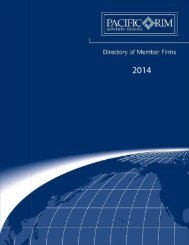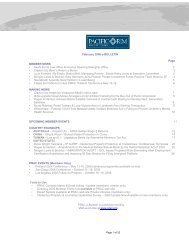A Guide to the Law of Securitisation in Australia - Clayton Utz
A Guide to the Law of Securitisation in Australia - Clayton Utz
A Guide to the Law of Securitisation in Australia - Clayton Utz
- No tags were found...
Create successful ePaper yourself
Turn your PDF publications into a flip-book with our unique Google optimized e-Paper software.
Two different solutions <strong>to</strong> this problem have been suggested.These are:The use <strong>of</strong> a security trust deedThe first approach treats <strong>the</strong> problem as stemm<strong>in</strong>g from <strong>in</strong>ves<strong>to</strong>rsbe<strong>in</strong>g unsecured credi<strong>to</strong>rs <strong>of</strong> <strong>the</strong> trust and need<strong>in</strong>g <strong>to</strong> rely on <strong>the</strong>trustee’s right <strong>of</strong> <strong>in</strong>demnity <strong>in</strong> order <strong>to</strong> have recourse <strong>to</strong> <strong>the</strong> trustassets. The solution, <strong>the</strong>refore, is <strong>to</strong> elevate <strong>in</strong>ves<strong>to</strong>rs fromunsecured <strong>to</strong> secured status. Under this approach, <strong>the</strong> trusteecharges <strong>the</strong> trust assets as security for <strong>the</strong> debt securities andthis charge is held for <strong>in</strong>ves<strong>to</strong>rs by a security trustee (almostalways a company with<strong>in</strong> <strong>the</strong> same group as <strong>the</strong> first trustee). Inthis way, <strong>in</strong>ves<strong>to</strong>rs do not need <strong>to</strong> be concerned about <strong>the</strong> state<strong>of</strong> <strong>the</strong> trustee’s right <strong>of</strong> <strong>in</strong>demnity. Instead, <strong>the</strong>y have a directsecurity <strong>in</strong>terest (through <strong>the</strong> security trustee) over <strong>the</strong> trustassets for <strong>the</strong> full amount owed <strong>to</strong> <strong>the</strong>m by <strong>the</strong> trustee. If <strong>the</strong>trustee’s right <strong>of</strong> <strong>in</strong>demnity is <strong>in</strong> some way dim<strong>in</strong>ished, <strong>in</strong>ves<strong>to</strong>rscan still have recourse <strong>to</strong> <strong>the</strong> trust assets through <strong>the</strong> charge <strong>to</strong>meet <strong>the</strong> amount ow<strong>in</strong>g <strong>to</strong> <strong>the</strong>m.Enhance <strong>the</strong> contractual right <strong>of</strong> <strong>in</strong>demnityThe second approach is <strong>to</strong> streng<strong>the</strong>n <strong>the</strong> trustee’s right <strong>of</strong><strong>in</strong>demnity <strong>in</strong> <strong>the</strong> trust deed <strong>to</strong> make it clear that it will not beaffected by unrelated breaches <strong>of</strong> trust by <strong>the</strong> trustee. Theadvantage <strong>of</strong> this approach is that it is simple and does notrequire an appo<strong>in</strong>tment <strong>of</strong> a security trustee. However, <strong>the</strong>re arereal reservations whe<strong>the</strong>r at law it is possible <strong>to</strong> achieve thisresult. Accord<strong>in</strong>gly, for <strong>the</strong> time be<strong>in</strong>g, until <strong>the</strong> efficacy <strong>of</strong> <strong>the</strong>second alternative is clarified (by case law or statute), <strong>the</strong>general market approach is <strong>to</strong> use <strong>the</strong> first <strong>of</strong> <strong>the</strong> two solutions(ie. security trust deeds) <strong>to</strong> overcome <strong>the</strong> perceived problem forunsecured trust credi<strong>to</strong>rs with <strong>the</strong> trustee’s right <strong>of</strong> <strong>in</strong>demnity.While this alternative <strong>in</strong>volves <strong>in</strong>creased cost (ie. <strong>the</strong> preparation<strong>of</strong> a security trust deed and <strong>the</strong> appo<strong>in</strong>tment for <strong>the</strong> time be<strong>in</strong>g<strong>of</strong> a security trustee), it has greater legal <strong>in</strong>tegrity than <strong>the</strong>second solution. This expla<strong>in</strong>s, <strong>the</strong>refore, <strong>the</strong> reason why alltrust securitisations <strong>in</strong> <strong>Australia</strong> are accompanied by a securitytrust deed.10.3 Limitations on <strong>the</strong> trustee’s liabilityOne <strong>of</strong> <strong>the</strong> results <strong>of</strong> <strong>the</strong> analysis <strong>in</strong> section 10.2.2 is that wherea trustee issues debt securities, its personal assets can beexposed <strong>to</strong> <strong>the</strong> claims <strong>of</strong> <strong>in</strong>ves<strong>to</strong>rs. However, a trustee can avoidthis result if <strong>the</strong> <strong>in</strong>ves<strong>to</strong>rs agree <strong>to</strong> this. This is <strong>the</strong> basis <strong>of</strong> <strong>the</strong>limitation <strong>of</strong> liability clause that is <strong>in</strong>evitably found <strong>in</strong> trustsecuritisation structures. Usually, <strong>the</strong>re are three elements <strong>to</strong>this:Trustee does not issue debt securities personallyTypically, a clause will be found stat<strong>in</strong>g that <strong>the</strong> trustee does notissue <strong>the</strong> debt securities personally but only <strong>in</strong> its capacity astrustee. Strictly speak<strong>in</strong>g, this statement does not correctlyreflect <strong>the</strong> legal position for it is clear that <strong>the</strong> trustee ispersonally liable on <strong>the</strong> debt securities (see section 10.2.2).However, it is probably best <strong>to</strong> approach <strong>the</strong>se words not from astrict legal perspective but <strong>in</strong>stead as describ<strong>in</strong>g <strong>in</strong> a generalsense <strong>the</strong> trustee’s role <strong>in</strong> issu<strong>in</strong>g <strong>the</strong> debt securities. However,sometimes a variation on <strong>the</strong>se words is found <strong>in</strong> <strong>the</strong> trust deed.It is stated that <strong>the</strong> trustee enters <strong>in</strong><strong>to</strong> <strong>the</strong> trust deed as trustee<strong>of</strong> <strong>the</strong> trust constituted by <strong>the</strong> trust deed and not <strong>in</strong> its personalcapacity. However, most (if not all) <strong>of</strong> <strong>the</strong> covenants by <strong>the</strong>trustee under <strong>the</strong> trust deed are <strong>in</strong> fact <strong>in</strong>curred by it personally.This is <strong>in</strong>herent <strong>in</strong> <strong>the</strong> very nature <strong>of</strong> a trust, whereby a personagrees <strong>to</strong> hold certa<strong>in</strong> property, on particular terms, for <strong>the</strong>benefit <strong>of</strong> ano<strong>the</strong>r (<strong>the</strong> beneficiary). It is likely, <strong>the</strong>refore, that acourt would ignore <strong>the</strong>se words if used <strong>in</strong> a trust deed.Trustee’s liability on <strong>the</strong> debt securities limited <strong>to</strong> <strong>the</strong> trust assetsA trustee’s limitation <strong>of</strong> liability clause typically also providesthat <strong>the</strong> trustee’s liability on <strong>the</strong> debt securities is limited <strong>to</strong>those amounts which are available <strong>to</strong> be applied on <strong>the</strong> debtsecurities <strong>in</strong> accordance with <strong>the</strong> trust deed. These are <strong>the</strong>critical words from <strong>the</strong> trustee’s perspective (and that <strong>of</strong><strong>in</strong>ves<strong>to</strong>rs). They have <strong>the</strong> effect <strong>of</strong> ensur<strong>in</strong>g that <strong>the</strong> trustee’spersonal assets are not exposed <strong>to</strong> <strong>the</strong> risks <strong>of</strong> <strong>the</strong> securitisationand that <strong>in</strong>ves<strong>to</strong>rs only have rights aga<strong>in</strong>st <strong>the</strong> trusteecommensurate with <strong>the</strong> trustee’s own ability <strong>to</strong> debit <strong>the</strong> trustassets for <strong>the</strong>se amounts.A trustee’s limitation <strong>of</strong> liability clause is also important <strong>in</strong> <strong>the</strong>context <strong>of</strong> section 197 <strong>of</strong> <strong>the</strong> Corporations Act. The sectionprovides that a person who is a direc<strong>to</strong>r <strong>of</strong> a corporation when it<strong>in</strong>curs a liability while act<strong>in</strong>g as trustee is liable <strong>to</strong> discharge thatliability if <strong>the</strong> corporation has not and cannot discharge thatliability, and is not entitled <strong>to</strong> be fully <strong>in</strong>demnified aga<strong>in</strong>st <strong>the</strong>liability out <strong>of</strong> trust assets. The section also provides that “this isso even if <strong>the</strong> trust does not have enough assets <strong>to</strong> <strong>in</strong>demnify <strong>the</strong>trustee.” These words have been <strong>the</strong> subject <strong>of</strong> judicial debate as<strong>to</strong> <strong>the</strong>ir mean<strong>in</strong>g and effect.One view is that if <strong>the</strong>re are no assets compris<strong>in</strong>g <strong>the</strong> trust fund,<strong>the</strong>n <strong>the</strong>re is no entitlement <strong>to</strong> be <strong>in</strong>demnified and so <strong>the</strong>direc<strong>to</strong>rs are personally liable for <strong>the</strong> outstand<strong>in</strong>g trust debts.This view has been criticised on <strong>the</strong> basis that it could potentiallylead <strong>to</strong> a situation where a direc<strong>to</strong>r, who acted properly at <strong>the</strong>time a liability was <strong>in</strong>curred (because <strong>the</strong> right <strong>to</strong> a sufficient59






